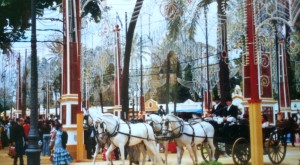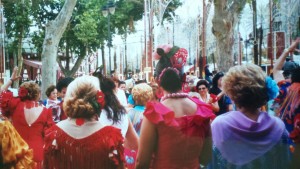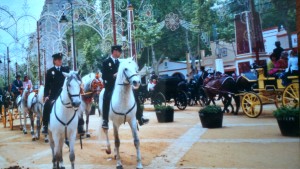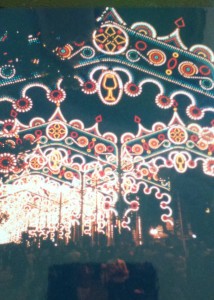In the north west of the city of Jerez on the Avenida Alvaro Domecq, in what was once the outskirts of town, there is a large, enclosed open space, the size of two football fields. This is the Parque Gonzales Hontoria, the sole purpose of which is to house the annual, week long Feria del Caballo (the Festival of the Horse). Already, at the end of April, the tented city that supports the Feria is taking shape, as rows of casetas, or tented rooms, are  constructed along the Parque’s wide avenues. to hold restaurants, bars and music venues (often all three) and this year there will be over two hundred of them ( see Plan here ). The casetas will barely contain all the visitors to the Feria, as they move around between them – a fino here, a tapa there – with the object of seeing and being seen and having a good time.
constructed along the Parque’s wide avenues. to hold restaurants, bars and music venues (often all three) and this year there will be over two hundred of them ( see Plan here ). The casetas will barely contain all the visitors to the Feria, as they move around between them – a fino here, a tapa there – with the object of seeing and being seen and having a good time.
The fair dates back to the thirteenth century, when it was established by King Alfonso X, conqueror of the, formerly Moorish, city. There are formal proceedings and competitions, in dressage, show jumping and carriage driving, in the large indoor exhibition hall in one corner of the park and other venues across the city, and as part of Equisur, the horsey commercial fair which runs parallel to the Feria. Many of these are ticketed and sell out in advance, but some are free ( see Programme here ).
My neighbour once described the Feria to me as ‘a week long party, where you meet everyone you have ever known’. A pardonable exaggeration perhaps, but this ancient fair energises the whole town and provides an annual  opportunity for Jerezianos to come together. People return from all corners of the globe to Jerez for the Feria, to catch up, talk, dance and drink sherry. I know people who maintain a pied de terre in Jerez for the single purpose of being able to stay in it when they return for this event. And the flamenco guilds are out and about, singing, playing and dancing along the Paseo de las Palmeras, one of the major avenues which runs the length of the park, to ensure that it has that distinctive, Jereziano flavour.
opportunity for Jerezianos to come together. People return from all corners of the globe to Jerez for the Feria, to catch up, talk, dance and drink sherry. I know people who maintain a pied de terre in Jerez for the single purpose of being able to stay in it when they return for this event. And the flamenco guilds are out and about, singing, playing and dancing along the Paseo de las Palmeras, one of the major avenues which runs the length of the park, to ensure that it has that distinctive, Jereziano flavour.
Criss-crossed with tall palms and poles for the erection of coloured lights, the park stands empty for most of the year (although the indoor arena is used year round). Then, as May approaches the lines of casetas take form and the anticipation builds. Traditional dress is de rigeur, whole  families, three or four generations, stroll around the park in gaily coloured dresses or matador pants and boleros, from aging grand parents to tiny children. There is exquisite beauty on show, the olive skin tones, raven hair and dark eyes of both genders, slim and beautiful in this unforgiving garb. There are plenty of shops in town where costumes may be bought, though the cogniscienti have theirs made. Even those folk who don’t dress traditionally tend to dress their best ( it is, by and large, the tourists who are be-jeaned ). The real accessory of choice, however, is a horse or a horse and carriage.
families, three or four generations, stroll around the park in gaily coloured dresses or matador pants and boleros, from aging grand parents to tiny children. There is exquisite beauty on show, the olive skin tones, raven hair and dark eyes of both genders, slim and beautiful in this unforgiving garb. There are plenty of shops in town where costumes may be bought, though the cogniscienti have theirs made. Even those folk who don’t dress traditionally tend to dress their best ( it is, by and large, the tourists who are be-jeaned ). The real accessory of choice, however, is a horse or a horse and carriage.
Many associations, clubs and the richer families own and maintain horse-drawn carriages, which parade up and down the avenues. It was at the Feria that I first saw a carriage with five, and even seven, horses in harness, (although the latter is very rare) instead of the more usual two, four or six. There are also many single horsemen and women – this is a city in which, within ten minutes walk of the centre of town, one can find vast stables occupying bodega like buildings for the housing of horses. Most people cannot, of course, afford the expense of maintaining a horse, but they can afford to belong  to unions and associations, which occupy the best, corner sites for eating, drinking and viewing the paseos within the park. Tourists please note, one may find oneself exiled to one of the smaller avenues away from the main drives, if one wants to eat and eating at the Feria is expensive! If a formal meal is what is required, then book well in advance, for a table at one of the restaurants which spring up in the park, outliers of those from the centre of the town.
to unions and associations, which occupy the best, corner sites for eating, drinking and viewing the paseos within the park. Tourists please note, one may find oneself exiled to one of the smaller avenues away from the main drives, if one wants to eat and eating at the Feria is expensive! If a formal meal is what is required, then book well in advance, for a table at one of the restaurants which spring up in the park, outliers of those from the centre of the town.
In the evening the Feria becomes even more vibrant, with the casetas full to bursting and everyone dancing (a sevillana is not so difficult after a few sherries, even if you’re a tourist, though bear in mind that folk here learn to dance a sevillana as soon as they can walk). The lights are switched on just as dusk darkens to night and, especially at the weekends, the whole city seems to come out to play. Some casetas open for the first time, these tend to have the latest music, hip hop or whatever is the fashion and they will not close until the later hours of the following morning, attracting the young away from their family groups. But it is the citizens of the town and of the Feria who make this such a wonderful event as they walk along the wide avenues, ready to dance and sing, clapping to a flamenco rhythm and looking out for friends, old and new. The Feria del Caballo is a phenomenon, but a phenomenon which belongs to the Jerezianos.
The photographs used in this blog post are from Ferias past – the 2015 version not yet having happened. More can be found on Pinterest at the usual JulieJ pinboards. Or try these blog posts


 RSS – Posts
RSS – Posts